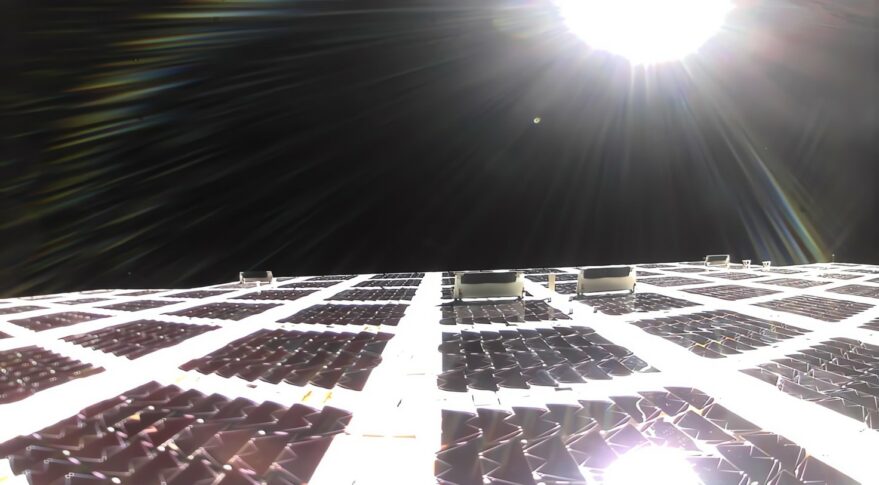TAMPA, Fla. — A year and a half after netting around $417 million through its IPO, AST SpaceMobile is seeking more funds to accelerate a direct-to-smartphone constellation that has fallen behind a key regulatory deadline.
Despite successfully deploying its gigantic phased array antenna this week, AST SpaceMobile’s BlueWalker-3 prototype satellite will miss a Nov. 22 deadline for securing frequencies that have been provisionally assigned to the constellation.
AST SpaceMobile has asked international regulators for 18 more months to give BlueWalker-3 time to climb to around 700 kilometers above the Earth to lock in rights to this spectrum, which its future satellites need to bring 5G to smartphones outside cellular coverage.
The International Telecommunication Union (ITU), an affiliate of the United Nations that manages spectrum rights for satellites, said Nov. 4 it expects to decide whether to extend the deadline in March after asking for more information.
The ITU will “continue to take into account the frequency assignments” in the meantime.
The information the ITU needs from Papua New Guinea, which is managing AST SpaceMobile’s spectrum filings, includes the time it would have taken for BlueWalker-3 to reach its destination under previous plans to launch on a Russian Soyuz rocket in 2021.
Following delays with launch broker GK Launch Services’ primary passenger for this Soyuz launch, AST SpaceMobile decided in August 2021 to move its reservation to Falcon 9.
Without an ITU extension, AST SpaceMobile risks losing the priority it has in Q and V band spectrum to another operator, complicating efforts to guard against interference.
The Q and V band frequencies are needed to direct the traffic its satellites pick up from smartphones beyond the reach of cell towers to gateways on the ground, where this data is then routed to the cellular operator.
Bolstering finances
The Texas-based company said during a quarterly earnings call Nov. 14 that it is exploring funding options to speed up satellite deployments. This could help any plan to regain priority access to spectrum if its extension request fails.
AST SpaceMobile, one of several space firms to go public last year by merging with a special purpose acquisition company (SPAC), did not say how much extra capital it is looking for.
The company said it already has enough financial resources to cover operations over the next 12 months, with nearly $200 million in cash reserves at the end of September.
Scott Wisniewski, AST SpaceMobile’s chief strategy officer, told SpaceNews “there are multiple ways to bring into use the frequency, but we are focused on the current process and bringing into use the frequencies with BlueWalker 3” under the ITU’s regulatory process.
He declined to comment specifically on the venture’s financing plans, but said more funds could help accelerate the development of technology and its manufacturing capabilities.
Any additional capital the venture secures would not bring forward the current timeline for deploying its first five revenue-generating BlueBird satellites in late 2023, he said.
AST SpaceMobile had previously planned to deploy 20 BlueBirds by the third quarter of 2023 before pandemic-related production issues took hold.
As part of efforts to reduce the impact of these delays, the company said in August that its first five BlueBirds, known as Block 1, will be 50% smaller than initially planned — now roughly the same size and weight as the 1,500-kilogram BlueWalker-3.
The company did not give an updated timeline for launching satellites beyond 2023 during its Nov. 14 quarterly earnings call, although it said it plans to start ramping up manufacturing next year toward producing six BlueBirds per month.
Previously, the company had plans to deploy 110 BlueBirds before the end of 2024 to reach “substantial global” mobile coverage.
Testing unaffected
Wisniewski said the next step for BlueWalker-3 after unfolding its phased array antenna — the largest deployed commercially in low Earth orbit — is to deploy smaller antennas that will test broadcasts in Q and V band spectrum.
This will happen “soon,” Wisniewski said, paving the way for the prototype to connect with a smartphone for the first time during the first quarter of 2023 — regardless of BlueWalker-3’s regulatory issue with the ITU.
“We currently have test licenses in a number of individual countries, including the U.S., which authorize us for transmissions, under certain limitations, in various [cellular] and satellite frequencies,” he said.
“We expect a few more approvals in other countries in the coming months, ahead of testing in Q1.”
Wisniewski said these tests will include transmission on several frequencies in the 800 MHz band used by mobile operators as well as Q and V band frequencies.
“Testing at our current altitude is unaffected by the ongoing ITU Radio Regulations Board review process,” he added.

